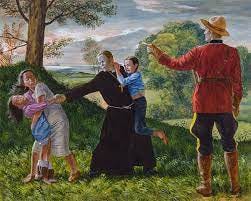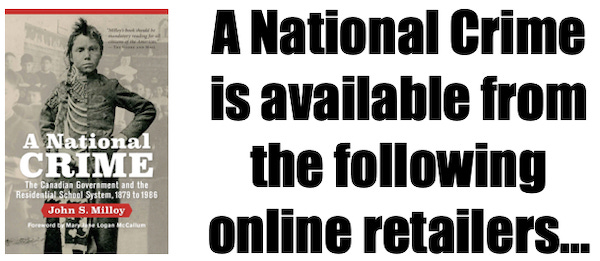REVIEW: A National Crime (a balanced look at the residential school systems)
A guest post by John C.A. Manley, author of “Much Ado About Corona”
Normally, I religiously avoid the cesspool of Canadian Mainstream Media. It’s depressing, I know it’s just a bunch of lies, and there’s not much point in me thinking about Canadian politics, since I live in Mexico now anyway.
Over the course of the past few days, though, I’ve delved in, because I’ve been investigating the phenomenon of “Orange Shirt Day”, a new statutory holiday meant to commemorate Canada’s crimes against indigenous people.
In doing so, I have learned a few things that I think are worth passing on.
“RESIDENTIAL SCHOOL DENIALISM” IS NOW A THING.
For those of us who have been accused of being “COVID-deniers” or “climate-change deniers”, the word “denialism” is a big red flag now. The term suggests there is one correct opinion on a complex issue, and that deviation from that narrow path is tantamount to heresy.
There are tons of articles about the scourge of “residential school denialism”, which appear to apply to cases in which people “minimize” or “downplay” the abuses that happened at residential schools.
For example, a tenured professor in Alberta was fired expressing the wrong views about residential schools. This obviously raises issues about academic freedom. Something weird is going on.
WHY IS THE RESIDENTIAL SCHOOL NARRATIVE BEING QUESTIONED NOW?
I have written previously about my suspicions regarding the government’s intentions in promoting “Orange Shirt Day”.
I have a better-formed thesis now. I think the goal is to shift focus away from the fact that 150 000 children were kidnapped and held captive for years as part of deliberately genocidal policies designed to wipe out indigenous cultures.
The CBC seems to want people to focus the number of deaths that occurred at residential schools, and what caused them.
As far as I’m aware, very few of the children who died at residential schools were murdered. Many died of illnesses such as tuberculosis. Although malnutrition and unsanitary conditions may have been contributing factors, I don’t think that schoolmasters were trying to kill the children. They were trying to “Kill the Indian in the child” by severing their family ties.
I think the government wants people to focus on the number of deaths as a sneaky way of downplaying the fact that 150 000 children will forcibly removed from their families in order to brainwash them with statist propaganda as part of a deliberate effort to destroy their cultures.
Yes, I’m aware I just repeated myself. It’s worth repeating.
To me, this is a horrifying crime against humanity. I don’t need further proof than that to convince me that Canada is a genocidal state. Whether 2000 or 10,000 kids died in custody is besides the point. The point is that tens of thousands of children were being held prisoner. That’s unacceptable.
THEY WANT US TO FOCUS ON THE NUMBER OF DEATHS THAT OCCURRED AT RESIDENTIAL SCHOOLS
The government of Canada seems to want people to focus on the number of deaths of that occurred at residential schools. How many children died in custody is a matter of debate amongst scholars.
According to one source:
Between 1931 and 1996, there were 139 Indian Residential Schools operating in Canada. In 2019, the National Centre for Truth and Reconciliation shared the names of 2,800 children who had died in those schools. At that time, it was believed that there were still an additional 1,600 unnamed children.
More recently, higher estimates have been published, including one by the National Centre for Truth and Reconciliation.
As an opinion piece in the Globe and Mail explains:
Detractors have stated that both federal and provincial governments kept careful records around the deaths of children sent to residential school. They claim government offices delivered, years ago, almost all these records to the Truth and Reconciliation Commission (TRC) or, later, to the National Centre for Truth and Reconciliation (NCTR) – and that the Centre is not making these records available…
The NCTR has so far identified 4,135 deaths of students who attended a residential school, and more will be added in an upcoming inclusive report. With the guidance of Indigenous communities, the NCTR constructed a memorial website to honour and commemorate these losses.
Some deniers have misunderstood the meaning of this memorial. They have found burial sites of children named on the website, and noted that some died in their home communities.
However, there were children who were sent home and died shortly afterward – or as the TRC darkly phrased it, “sent home to die.” The website thus includes children who passed away within approximately a year of discharge.
Huh. Kinda weird that they’re fudging the numbers, isn’t it? That’s not cool.
But do we really need to know the exact number of students that died?
In the lower estimate, about 1 in every 53 students died.
In the higher estimate, about 1 in every 36 died.
If we average those numbers out, we can guesstimate that about 1 in 45 students never made it out alive.
I hope that the reader shares my opinion that 1 in 45 is an unacceptably high mortality rate for any school. But I think that to focus on the number of deaths misses the point.
To me, the real story is:
150 THOUSAND CHILDREN WERE SYSTEMICALLY KIDNAPPED FROM THEIR HOMES AND HELD AS PRISONERS IN STATE-FUNDED BRAINWASHING CENTRES WHERE THEY WERE MISTREATED AND ABUSED AS PART OF A DELIBERATE CAMPAIGN OF GENOCIDE!
I think that getting people to focus on the unmarked graves is an exercise is misdirection.
What’s more, THERE ARE REAL QUESTIONS ABOUT THE USE OF GROUND-PENETRATING RADAR TECHNOLOGY.
There seems to be an active debate about the legitimacy of the methods used to discover unmarked graves. In many cases, the CBC has reported the “discovery” of unmarked graves that haven’t actually been exhumed. In other words, no human remains have actually been found.
Basically, government-funded archaeologists are using ground-penetrating radar technology to identify “suspected unmarked graves”.
Now, I am certainly not a residential school denialist, but I don’t trust the government, or archeologists, or the CBC. It sure seems to me like something fishy is going on.
I’ll just say it: I think the governement of Canada is pulling shenanigans in order to take control of the narrative around its own crimes against humanity.
But wait, there’s more!
In my r I learned that one Member of Parliament wants to pass a law against making “false assertions about residential schools”.
According to this CBC article:
NDP MP Leah Gazan, who got the House of Commons last October to unanimously recognize that genocide occurred at residential schools, now wants to take the issue a step further by drafting legislation to outlaw attempts to deny that genocide and make false assertions about residential schools.
"Denying genocide is a form of hate speech," said Gazan, who represents the riding of Winnipeg Centre.
All this is of course reminiscient of Canada’s long-standing taboo against contradicting the official narrative around the Holocaust.
Speaking of which, do you know that Trudeau made it a criminal offence to “condone, deny, or downplay” the Holocaust?
According to a CBC article from May 2022:
The government's plan to criminalize denial of those events — outside of private conversation — was first unveiled inside this year's 280-page federal budget…
The amendment would "prohibit the communication of statements, other than in private conversation, that willfully promote antisemitism by condoning, denying or downplaying the Holocaust."
A perusal of the Criminal Code shows that this amendment has been passed into law. Here’s a direct quote:
So there you have it, folks. You’ve got free speech in Canada… except for when you don’t.
Anyway, in the interests of lending my support to those who question the government’s framing of things, I present this guest post by John C.A. Manley, which is a review of A National Crime, a recent book about Canada’s residential school systems.
"A National Crime" (a balanced look at the residential school systems)
by John C.A. Manley
In my novel, Much Ado About Corona, one of the indigenous characters, affectionately called "Granddad" by the people of Moosehead, was abducted as a child by the RCMP and put into the Canadian residential school system. Now, at the end of his life, he again finds himself under government "care," locked away in a COVID-restricted nursing home.
Today is National Day for Truth and Reconciliation in Canada. In recognition, I wanted to give a short review of the principle book I referenced to craft Granddad's back story: A National Crime: The Canadian Government and The Residential School System, 1879 to 1986 by John S. Milloy. Considered "One of the 100 most important Canadian books ever written" by the Literary Review of Canada, it provides a surprisingly balanced overview of what took place, without resorting to unsubstantiated hype or otherwise excusing the neglect and abuse many (but not all) of the children suffered.
I came to the book expecting damning testimonials and eye-witness accounts from the indigenous population. Instead, I discovered a collection of reports, letters, articles and other written material by non-indigenous citizens — dating back as far as the 1800s — speaking out against the injustices they saw. Many of the citations are from government paid inspectors exposing how the children were “overworked, overtired and underfed” and subjected to a “poor diet” of “unfamiliar food,” “overcrowding” and “poor ventilation" that inevitably led to diseases like tuberculosis.
Despite such hard-to-read reports, I felt the book provided a balanced and not so absolutely dismal overview of this “national crime.” In many cases, some students did benefit from certain schools, especially those children coming from homes where the parents had neglected or abandoned them for drink or other vices. Many of the staff and schoolmasters were ardently looking out for the wellbeing of the children, at their own expense, but simply had insufficient funding or concern from the government. As the chief medical officer of the Indian Department reported in 1907, a"trail of disease and death has gone on almost unchecked by any serious effort on the part of Indian Affairs."
In spite of little mention of the sexual abuse allegations, John S. Milloy's extensive historical references presents a crime scene that cannot be excused. While much of the aim of the residential school system may have been rooted in good intentions to improve the future of native children, the benefits of “killing the Indian and saving the child” were far outweighed by the negatives of what very much neared an attempt at cultural genocide.
You can purchase a copy of A National Crime: The Canadian Government and The Residential School System through your local bookstore or online.
John C. A. Manley is the author of the full-length novel, Much Ado About Corona: Dystopian Love Story. He is currently working on the sequel, Brave New Normal. John lives in Stratford, Ontario, with his son Jonah, and the ever-present spirit of his late wife, Nicole. You can subscribe to his email newsletter, read his full bio or find out more about his novel.










Excellent post :)
Will check the book by Milloy at some point.